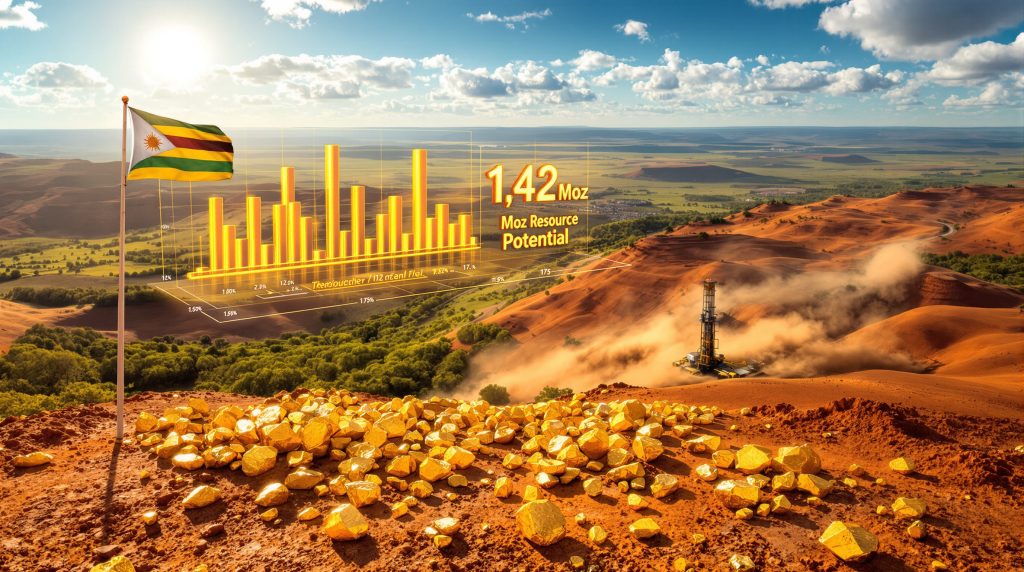Understanding Zimbabwe's Largest Untapped Gold Discovery
The Ariana Resources Dokwe gold project in Zimbabwe represents a significant development in Zimbabwe's mining landscape, containing more than one million ounces of identified gold resources within an extensive 12-kilometre mineralised corridor. Situated in the Tsholotsho District of western Zimbabwe, this flagship asset exemplifies the substantial mineral potential that exists within the country's historically productive gold-bearing geological formations.
Recent exploration initiatives have revealed that systematic drilling has covered merely 10% of the total mineralised strike length, indicating considerable expansion opportunities remain across the broader licence area. The geological setting occurs within the Archaean Tshabezi Formation, forming part of the western Bulawayo-Bubi Greenstone Belt, a region recognised for hosting world-class gold deposits throughout southern Africa.
Modern exploration techniques are uncovering substantial mineral concentrations that remained concealed for decades within Zimbabwe's established mining districts. The scale and continuity of mineralisation at Dokwe suggests this discovery could fundamentally alter the country's gold production profile, particularly as gold price analysis indicates continued market strength for precious metals investments.
Current Exploration Activities Transform Project Understanding
Advanced Drilling Campaign Methodology
Ariana Resources has commenced an intensive 4,000-metre reverse circulation drilling programme targeting four high-priority zones identified through comprehensive soil sampling and advanced geological modelling techniques. This initial phase represents the foundation of a broader 11,000-metre exploration strategy designed to systematically evaluate and expand the existing resource base beyond current estimates.
The 26-hole drilling campaign focuses specifically on testing newly identified geochemical anomalies while extending known high-grade zones at Dokwe North and Central areas. Dr Kerim Sener, managing director of Ariana Resources, has indicated that initial assay results are anticipated before the conclusion of 2025, with potential programme extensions to include metallurgical sampling activities at Dokwe Central.
Current drilling priorities include:
• Extension of established high-grade mineralised zones at Dokwe North and Central locations
• Systematic testing of newly identified geochemical anomalies from recent soil sampling programmes
• Validation of structural controls governing gold mineralisation distribution
• Collection of metallurgical samples for processing optimisation studies
The reverse circulation drilling methodology provides rapid sample collection capabilities while maintaining cost-effectiveness compared to diamond core drilling approaches. This technique proves particularly suitable for testing multiple targets across the extensive 12-kilometre corridor, enabling systematic evaluation of strike extensions and resource expansion potential.
Resource Expansion Potential Analysis
The most compelling aspect of the Dokwe project lies in its substantial untested potential. With 90% of the 12-kilometre mineralised strike length remaining systematically undrilled, the discovery potential extends far beyond current resource estimates. Historical intercepts at the Sinkwe Prospect have demonstrated significant mineralisation with results including 7.3 metres at 6.63 g/t Au, while the Siduli Pan Area has revealed exceptional point grades reaching 81.09 g/t Au over 0.5 metres.
The combination of extensive strike length with minimal historical exploration suggests substantial discovery potential remains untested, potentially expanding the resource base significantly beyond the current million-ounce estimate.
Recent geological reinterpretation has identified multiple high-priority exploration targets based on structural geology analysis and geochemical anomaly patterns. These targets benefit from the understanding that gold mineralisation at Dokwe occurs primarily at intersections of sub-vertical shear zones with southeast-dipping lithological contacts, concentrated within dacite, tuff, and porphyry host rock units.
Economic Projections and Investment Considerations
Financial Metrics and Development Economics
The economic attractiveness of the Ariana Resources Dokwe gold project in Zimbabwe stems from several key factors that distinguish it within Zimbabwe's mining sector. High-grade zones averaging 1.54 g/t gold within measured and indicated resource categories provide superior economics compared to many existing operations, supporting reduced mining costs per ounce and enhanced cash flow generation potential.
Project Economic Advantages:
| Factor | Benefit | Impact |
|---|---|---|
| High-grade mineralisation | Lower mining costs per ounce | Enhanced project margins |
| Established infrastructure | Reduced capital requirements | Faster development timeline |
| Favourable jurisdiction | Political stability | Reduced investment risk |
| Dual exchange listing | Diverse funding sources | Improved capital access |
The project's positioning within Zimbabwe's established mining framework provides access to existing infrastructure networks, including processing facilities and transportation corridors. This infrastructure advantage reduces both capital expenditure requirements and operational complexity, contributing to improved project economics and shorter development timelines.
Market Positioning and Valuation Context
Current gold market surge conditions provide strong support for project development economics, with the gold price forecast indicating continued upward momentum. The dual listing strategy on both AIM and ASX exchanges offers Ariana Resources access to diverse investor bases and multiple funding sources for advancing development phases.
Furthermore, the investment outlook for gold remains positive due to ongoing geopolitical tensions and economic uncertainties. This market environment supports the development of high-quality gold projects like Dokwe, particularly those with established resource bases and clear development pathways.
Disclaimer: Financial projections and development timelines remain subject to completion of detailed feasibility studies and may vary based on market conditions, technical results, and regulatory requirements.
Geological Framework and Mineralisation Controls
Structural Geology and Host Rock Characteristics
Gold mineralisation at the Dokwe project occurs within a complex geological environment characterised by specific structural controls and favourable host rock units. The primary mineralisation controls include intersections of sub-vertical shear zones with southeast-dipping lithological contacts, creating optimal conditions for gold concentration and preservation.
Key Geological Features:
• Shear Zone Systems: Sub-vertical orientations intersecting with lithological boundaries
• Host Rock Units: Dacite, tuff, and porphyry formations providing favourable chemistry
• Structural Complexity: Folding and thrust faulting systems enhancing mineralisation
• Regional Setting: Archaean Tshabezi Formation within Bulawayo-Bubi Greenstone Belt
The geological setting demonstrates characteristics typical of world-class gold deposits found within Archaean greenstone belt environments. Similar geological terranes in Western Australia and other regions of southern Africa have produced significant gold resources, suggesting the Dokwe area's broader mineral potential remains underexplored.
Exploration Target Generation and Methodology
Systematic soil geochemistry programmes have identified numerous high-priority targets along the 12-kilometre mineralised corridor. The geological modelling approach incorporates structural geology interpretation with geochemical anomaly patterns to optimise drill target selection and maximise discovery potential.
Advanced exploration techniques employed at Dokwe include comprehensive soil sampling grids, detailed geological mapping, and structural analysis to understand mineralisation controls. These methodologies have proven effective in identifying drill targets that have subsequently returned significant gold intercepts, validating the exploration approach.
Regional Asset Comparison and Market Position
Zimbabwe Gold Sector Context
Zimbabwe's gold mining sector has historically depended on smaller-scale operations and artisanal mining activities, with limited large-scale modern mining developments. The Ariana Resources Dokwe gold project in Zimbabwe's scale and systematic exploration approach position it uniquely within this context, potentially representing a new generation of Zimbabwean gold mining operations.
Recent developments in Zimbabwe's gold sector include production increases at existing operations such as Blanket Mine, which reported a 3% output increase, and renewed feasibility activities at projects including Namib Minerals' Redwing and Mazowe gold assets. These developments indicate growing confidence in Zimbabwe's gold sector potential and regulatory environment.
Comparative Project Advantages:
• Resource Scale: Million-ounce resource base exceeding typical Zimbabwean projects
• Systematic Approach: Modern exploration techniques and resource estimation methods
• Infrastructure Access: Proximity to established mining infrastructure networks
• International Backing: London and Australian stock exchange listings providing capital access
Investment Climate and Sector Growth
Gold projects throughout Zimbabwe have attracted increasing investor attention as mining companies seek opportunities within underexplored mineral belts across southern Africa. The combination of geological potential, established mining framework, and government support for mining development creates favourable conditions for project advancement.
The regional geological setting within the Bulawayo-Bubi Greenstone Belt hosts several significant gold deposits, indicating the area's broader mineral endowment remains underexplored. This geological context supports the potential for additional discoveries beyond the current Dokwe resource estimate.
Development Timeline and Implementation Strategy
Project Advancement Phases
The systematic development of the Dokwe project follows a structured timeline designed to optimise resource definition, economic assessment, and production preparation. Current drilling activities represent the initial phase of comprehensive project evaluation leading toward full-scale development.
Development Milestones:
-
Q4 2025: Completion of initial 4,000-metre drilling programme with first assay results
-
Q1 2026: Resource update incorporating new drilling data and geological interpretation
-
2026: Definitive feasibility study completion with detailed economic assessment
-
2027: Final permitting processes and development financing arrangements
-
2028-2029: Construction phase including infrastructure and processing facility development
-
2030: Target production commencement with initial gold production
The timeline reflects industry-standard development phases while accounting for the specific requirements of Zimbabwean regulatory processes and infrastructure development needs. Extended drilling programmes may be incorporated based on initial results and resource expansion potential.
Risk Management and Mitigation Strategies
Project development incorporates comprehensive risk assessment and mitigation strategies addressing technical, regulatory, and market factors. The established infrastructure framework in Zimbabwe reduces construction risks while government support for mining development provides regulatory stability.
Key Risk Areas and Mitigation Approaches:
• Technical Risks: Comprehensive feasibility studies and metallurgical testing programmes
• Regulatory Changes: Strong government relationships and established mining law framework
• Market Volatility: Conservative economic modelling and potential hedging strategies
• Infrastructure Development: Partnerships with regional service providers and contractors
Strategic Significance for Zimbabwe's Mining Future
National Economic Impact Potential
The successful development of the Dokwe project could contribute substantially to Zimbabwe's economic recovery and mining sector revitalisation. Large-scale gold production would generate significant foreign exchange earnings while creating direct and indirect employment opportunities in rural areas of the Tsholotsho District.
Beyond immediate economic benefits, the project's development could demonstrate Zimbabwe's renewed attractiveness for international mining investment, potentially catalysing broader sector development and additional foreign direct investment flows into the mining sector.
Potential National Benefits:
• Employment Creation: Direct mining jobs and indirect economic opportunities in regional communities
• Foreign Exchange Generation: Gold export revenues supporting national economic stability
• Technology Transfer: Modern mining techniques and skills development for local workforce
• Infrastructure Development: Regional infrastructure improvements benefiting broader community
International Investment Attraction
The Dokwe project's advancement represents an important test case for Zimbabwe's mining investment climate. Successful development could establish a positive precedent for international mining companies evaluating opportunities within Zimbabwe's mineral-rich geological terranes.
The project benefits from Ariana Resources' established international presence and dual-exchange listings, providing credibility and access to global capital markets. This international connectivity could facilitate knowledge transfer and best practice implementation throughout the development process.
Future Prospects and Long-term Development Strategy
The Ariana Resources Dokwe gold project in Zimbabwe stands positioned at a critical development juncture, with ongoing exploration activities set to unlock substantial value for stakeholders while advancing Zimbabwe's gold sector capabilities. Current drilling programmes will provide essential data for resource expansion and economic optimisation, establishing the foundation for long-term production planning.
As assay results emerge throughout the remainder of 2025 and into 2026, the project's development trajectory will become increasingly defined. The combination of significant resource potential, favourable geological setting, and strategic location creates compelling opportunities for both Ariana Resources and Zimbabwe's broader mining sector revival.
Furthermore, the implementation of effective gold investment strategies becomes increasingly important as projects like Dokwe demonstrate the potential for substantial returns in underexplored mineral districts. The systematic exploration approach being employed at Dokwe demonstrates modern mining industry practices while respecting local community interests and environmental considerations.
This balanced development strategy positions the project for sustainable long-term success within Zimbabwe's evolving mining landscape. However, investors should recognise that the drilling programme at Dokwe represents just the beginning of a comprehensive exploration and development process that will ultimately determine the project's commercial viability.
Disclaimer: This analysis is based on publicly available information and should not be construed as investment advice. Mineral resource estimates, development timelines, and economic projections remain subject to detailed feasibility studies and may vary based on technical, market, and regulatory factors. Potential investors should conduct independent due diligence and consult qualified professionals before making investment decisions.
Looking for the Next Major African Gold Discovery?
Discovery Alert's proprietary Discovery IQ model delivers real-time alerts on significant ASX mineral discoveries, instantly empowering subscribers to identify actionable opportunities ahead of the broader market. Understand why major mineral discoveries can lead to substantial market returns by exploring historic examples of exceptional outcomes, then begin your 30-day free trial today to position yourself ahead of the market.




